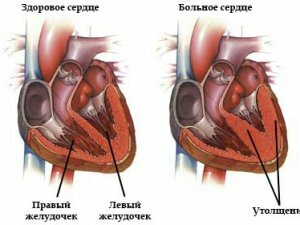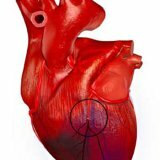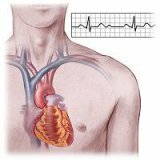Hypertrophy of the right ventricle
 The heart is the engine of our body and care of it should be in the first place. Hypertrophy is not as such a disease, it's just an increase in the size of some organ that signals a lack of anything in the body.
The heart is the engine of our body and care of it should be in the first place. Hypertrophy is not as such a disease, it's just an increase in the size of some organ that signals a lack of anything in the body.
Description cardiac hypertrophy
ventricular hypertrophy( differently right ventricular hypertrophy and right ventricular hypertrophy) - it is a heart condition, wherein the right ventricle undergoes a change in size due to an increase in muscle tissue( cardiac fibers), and this in turn leads toOverload of the heart.
The increase in the ventricle of the heart occurs in people of different ages, but for the most part it is diagnosed in children. It is worth noting that cardiac hypertrophy can be observed in newborns, because they have an intensified work of the heart in the first days of life and on the right side of the heart.
 But most often, ventricular hypertrophy is pathological and may indicate the existence of congenital heart disease.
But most often, ventricular hypertrophy is pathological and may indicate the existence of congenital heart disease.
As you know, the human heart has a four-chambered and two right-hand parts of the heart that regulate the pulmonary circulation, also called small. And the two left parts are responsible for the work of a large circle, or system. In the normal state of the heart, blood pressure in the right sections is less. If a person has congenital heart defects or any malfunction of the heart, then this rule is broken, which leads to an overload of the right ventricle of the heart, as it accounts for more blood flow than normal, and then to its hypertrophy.
consequences of ventricular hypertrophy, right side of the heart
emergence of right ventricular infarction speaks not only to increase the right heart and congestion, but also about what the heart is no longer able to cope with the load. In addition, the increase in the myocardium leads to a violation of the electroconductive properties of the heart, and this in turn can lead to malfunctions in contraction of the heart muscle, the occurrence of arrhythmia. Also, an increase in the ventricle can lead to changes in the structure of the pulmonary vessels and arteries. They become hard and they develop a hardening, which leads to increased blood pressure in the pulmonary circulation, its low permeability, which in turn can lead to the syndrome of Eisenmenger.
Causes of hypertrophy of the ventricle
- The tetrad of Fallot. It is a congenital heart disease that causes blue baby syndrome. Such a vice is found in children of the first year of life and is characterized by a violation of outflow of blood from the right ventricle.
- Change in interventricular septum. With such a defect, the two departments seem to communicate with each other, the blood mixes there, and then comes to the organs, carrying an insufficient amount of oxygen. In order to make up for the lack of nutrition of the organs, the heart begins to work through force, which leads to hypertrophy.
- Pulmonary hypertension. It leads to an increase in the pulmonary artery pressure. That your turn can lead to dizziness, shortness of breath and fainting.
- Stenosis of the valve of the lungs. It can disrupt the current in the artery from the right ventricle.
diagnosis of hypertrophy of the right side of the heart
initially increase the right ventricle can be diagnosed using an electrocardiogram, but, unfortunately, on the ribbon, the results can only recognize failure in conductivity, and the sheer size of the ventricle can not be determined. Therefore, the most reliable way to diagnose is to conduct an ultrasound of the heart. With this method of research, you can determine not only the size of the heart, but also various defects in it, as well as the location of their location. It also determines the force of blood pressure in the heart chambers and the correctness of its ejection through the places of defects in the heart.
However, it should be noted that changes in the possible, not only the electrical conductivity of the heart during ventricular hypertrophy, but also in some other cases, for example, after undergoing heart surgery or correction of defect.
Hypertrophy of the ventricle is a very dangerous syndrome, which can lead to various kinds of heart diseases. Therefore, regularly do an ECG for the timely detection of malfunctions in the heart.



